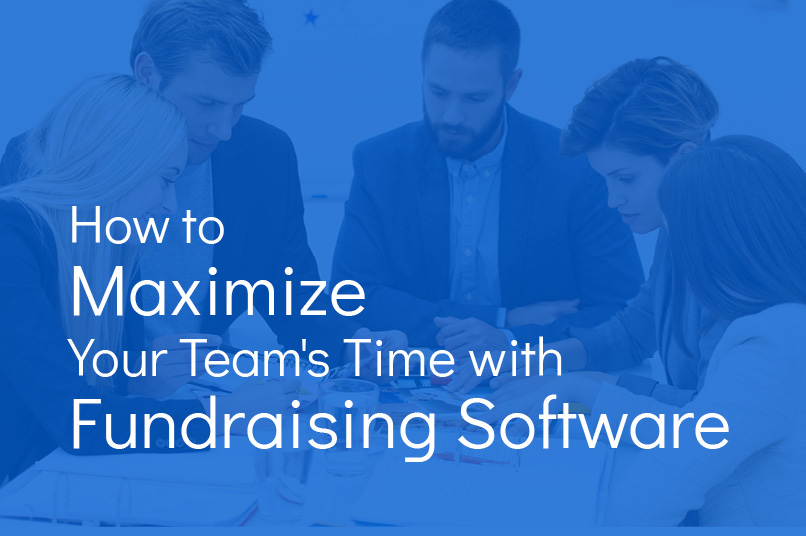 Think back to your team’s last fundraising campaign. Would you consider the fundraiser a success? Did you have the bandwidth to adequately plan, launch, and run the campaign? Did you find it easy to juggle your team’s schedule along with fundraising activities? Or, were there fundraising tasks that took far longer than they should have?
Think back to your team’s last fundraising campaign. Would you consider the fundraiser a success? Did you have the bandwidth to adequately plan, launch, and run the campaign? Did you find it easy to juggle your team’s schedule along with fundraising activities? Or, were there fundraising tasks that took far longer than they should have?
As you reflect on these questions, keep in mind that this is a problem many organizations face. Fundraising can feel like a full-time job, and balancing it with your team’s practices, games, and tournaments presents an added challenge. However, using fundraising software can help you motivate more people to donate and maximize the time you have available.
Fundraising software automates the more repetitive parts of fundraising like collecting donations or sending donation receipts and thank-you emails. This means that fundraising requires less time and effort from your team while simultaneously being more effective.
In this guide, we’ll acknowledge a few of the most common fundraising pain points teams face and how fundraising software can limit time spent on these tasks:
- Common Team Fundraising Pain Points
- How Fundraising Software Saves Time
- How to Choose the Right Software
Because fundraising software saves time, it can also give you more flexibility with when and how your team fundraises. If your soccer team’s equipment gets damaged during a storm and you need the funds to repair it before the next game, fundraising software will allow you to kick off the campaign in just a few days.
Common Team Fundraising Pain Points
While each team will face unique challenges based on factors like location or parental involvement, there are a few common pain points that can sap your team’s time:
- Manual administrative tasks. Say you’re launching a new fundraiser and want to stay on top of donation tracking and communicating with donors. But you soon find yourself spending each spare moment entering donors’ information into a spreadsheet, sending out thank-you emails, and totaling up donations. Not only is this stressful and time-consuming, but it could also lead to inaccurate records or, at worst, improperly stored sensitive information.
- Limited pool of donors. It can be difficult to find new donors when your fundraising technique limits you to your local area. While you can sink hours of time into creating posters or reaching out to community members, there is a finite number of willing supporters near you (e.g., parents, friends, and family of team members). And because you’ve likely asked those in this audience to donate before, they could be struggling with donor fatigue and decide not to give this time.
- Slow or disorganized payment processing. In addition to requiring large blocks of time, tracking and organizing payments (especially cash and checks) can be prone to errors. Even funneling electronic payments through a third-party service like Venmo could cause problems that require your time to fix. For example, most of these services do not categorize payments neatly and limit how much money can be deposited and withdrawn from your account each week.
- Limited insight into fundraising progress. Tracking your campaign’s progress is the best way to ensure your team will reach its fundraising goal. Without these numbers, you might be using fundraising strategies that are ineffective and won’t take your team past the finish line. On the other hand, it might take you an hour to aggregate your fundraising data into an easy-to-visualize format, only to find that the statistics are now outdated due to an influx of new donations.
These pain points can impact any fundraiser, whether it’s a school-wide online auction or a charity basketball tournament that’s designed to benefit a single team. But when you only have a group of a few staff or parents to help out, you’ll each need to devote more time to keep the campaign running smoothly. However, fundraising software can quickly take care of the work of several fundraising helpers, allowing you to accomplish more with less effort.
How Fundraising Software Saves Time
With the right fundraising software, your team can quickly overcome the pitfalls of manual data entry and limited donor bases. Here are some of the ways your fundraising software can remove the obstacles between you and your fundraising goal:
- Automate repetitive tasks. Fundraising software automates repetitive tasks that could otherwise add up to hours of work if done manually. Work with a solution that takes on all of these tasks for you, from setting up donation pages to recording data to communicating with donors.
- Reach more donors with online fundraising. What if you could spend less time on outreach, but still reach more people? Crowdfunding, which NXUnite describes as “a fundraising format in which large amounts of people each donate a small amount of money to fund a project or venture,” is a popular way to raise money online. Fundraising software can easily facilitate it by creating shareable donation pages you can promote on social media, your website, and via email.
- Streamline the donation process. Instead of manually rounding up dozens of cash or check donations, accept gifts through your software and receive them in your account after your fundraiser ends. By making donating easier, you’ll give donors a more positive experience. Plus, they may find donating online to be more secure and choose to make a larger contribution.
- Track progress in real-time. Your team might have ambitious goals for its fundraisers, and access to the campaign’s progress is what you need to reach them. When you have software that automatically collects and shows your fundraising progress, you can find ways to boost your efforts and stay on track. For example, if your team starts falling behind, you could turn the fundraiser into a competition and offer the top earner a prize.
In addition to creating more positive donor experiences, you can build long-lasting relationships with donors by improving communication efforts. Make sure to thank donors and send a donation receipt any time they make a donation to your team. Fundraising software can automate the process for you, ensuring no gift goes unnoticed.
How to Choose the Right Software
Just as you should choose fundraising ideas that embrace your organization’s unique strengths and needs, you should look for software that fits your team’s requirements. More specifically, you should choose software that is designed for team fundraising rather than a solution geared toward large nonprofit organizations. These tools won’t be optimized for your fundraisers and will typically cost more.
As you browse team fundraising software options, think about some of the other requirements your team might have. Consider your budget and how you want to present the fundraiser online. 99Pledges’ listing in this guide to fundraising platforms suggests a solution that:
- Allows you to create a team- or school-wide donation page along with individual pages for each team member
- Specializes in fundraisers that get both students and parents involved
- Does not have platform or startup fees
Once you narrow down your options, be sure to book a demo with a sales representative so you can ask any questions you might have. Focus on inquiring about how the fundraising software could save your team time by automating repetitive tasks. Come prepared with some specific examples of the problems you’d like to solve to ensure the software will help you overcome them.
The Bottom Line
Investing in fundraising software is the best way to make the most of your time spent fundraising. It also has a host of other benefits—helping you reach more donors, raise more money, and strengthen donor relationships. And if your team is currently working with a software provider but is still facing these challenges, consider switching to an alternative.
About the Author
Brad Dowhaniuk is the co-founder of 99Pledges, which provides schools and teams with an easy-to-use, web-based fundraising solution to manage and drive success in Fun Runs, jog-a-thons, baseball hit-a-thons, and much more.






